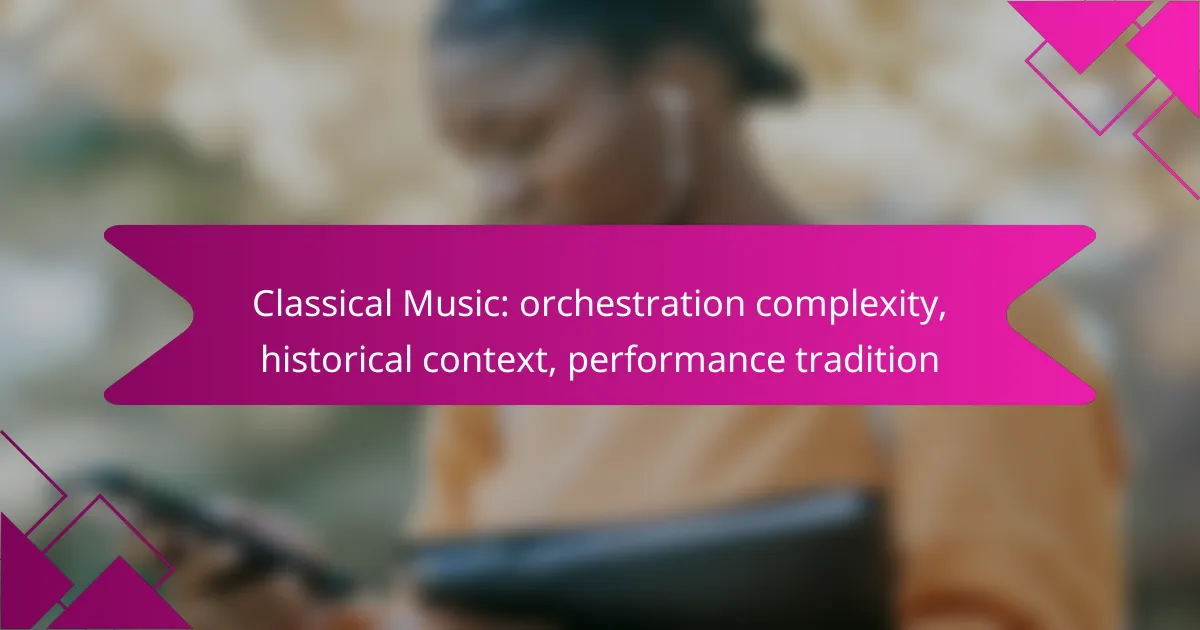Classical music is characterized by its intricate orchestration, which enhances the emotional depth and overall impact of compositions. The historical contexts in which these works were created reveal the cultural and social influences that shaped their development, while performance traditions continue to evolve, affecting interpretations and bringing unique nuances to each piece.
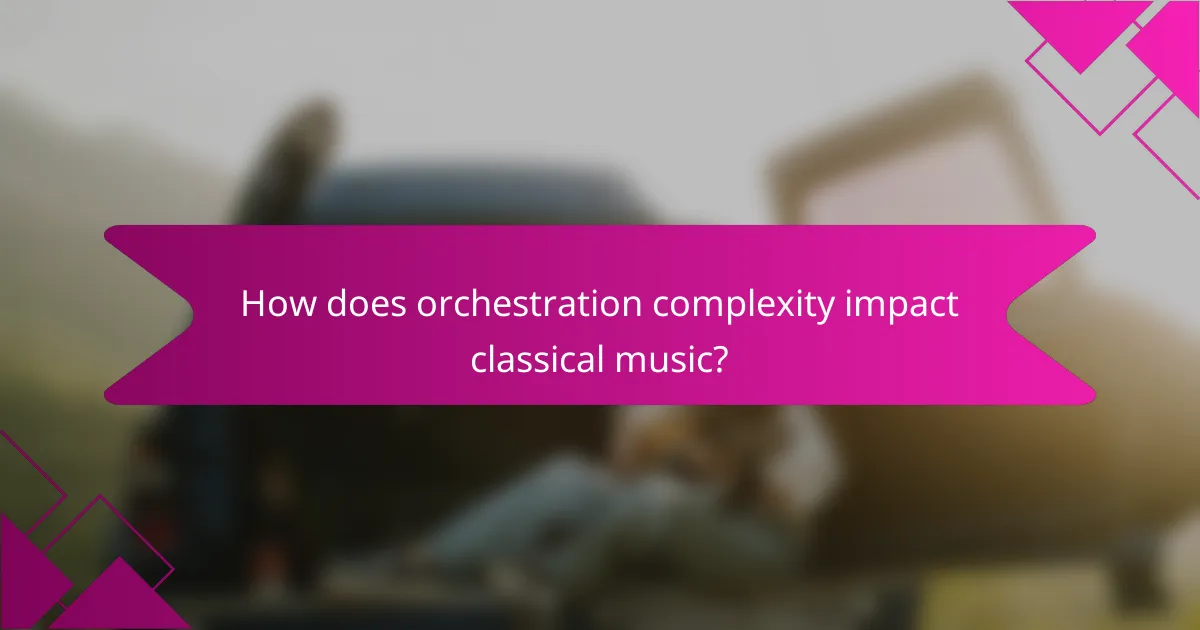
How does orchestration complexity impact classical music?
Orchestration complexity significantly influences the texture, emotional depth, and overall impact of classical music. A more intricate orchestration can enhance the richness of sound and provide greater expressive possibilities for composers and performers alike.
Role of instrumentation
The choice of instruments in orchestration plays a crucial role in shaping the character of a piece. Different instruments have unique timbres and ranges, allowing composers to create varied emotional landscapes. For instance, strings often convey warmth and intimacy, while brass can evoke power and grandeur.
Understanding the capabilities and limitations of each instrument is essential for effective orchestration. Composers must consider factors such as range, dynamic capabilities, and the blend of sounds to ensure that the orchestration complements the musical narrative.
Texture and harmony
Orchestration complexity affects the texture and harmony of a composition by determining how different musical lines interact. A dense orchestration can create a rich, layered texture, while a more sparse arrangement may highlight individual melodies. This interplay can evoke various emotional responses from the audience.
Harmonically, complex orchestration allows for intricate chord structures and modulations, enhancing the music’s depth. Composers often use counterpoint and harmony to create tension and resolution, which are vital for engaging listeners.
Examples from orchestral works
Many renowned orchestral works showcase the impact of orchestration complexity. For example, Gustav Mahler’s symphonies are known for their elaborate orchestration, which combines a vast array of instruments to create a rich sound palette. His use of woodwinds and brass adds layers of color and emotion to the music.
Another example is Igor Stravinsky’s “The Rite of Spring,” which employs complex rhythms and innovative orchestration to evoke primal energy. The diverse instrumentation and intricate textures contribute to the work’s groundbreaking nature and lasting influence on classical music.
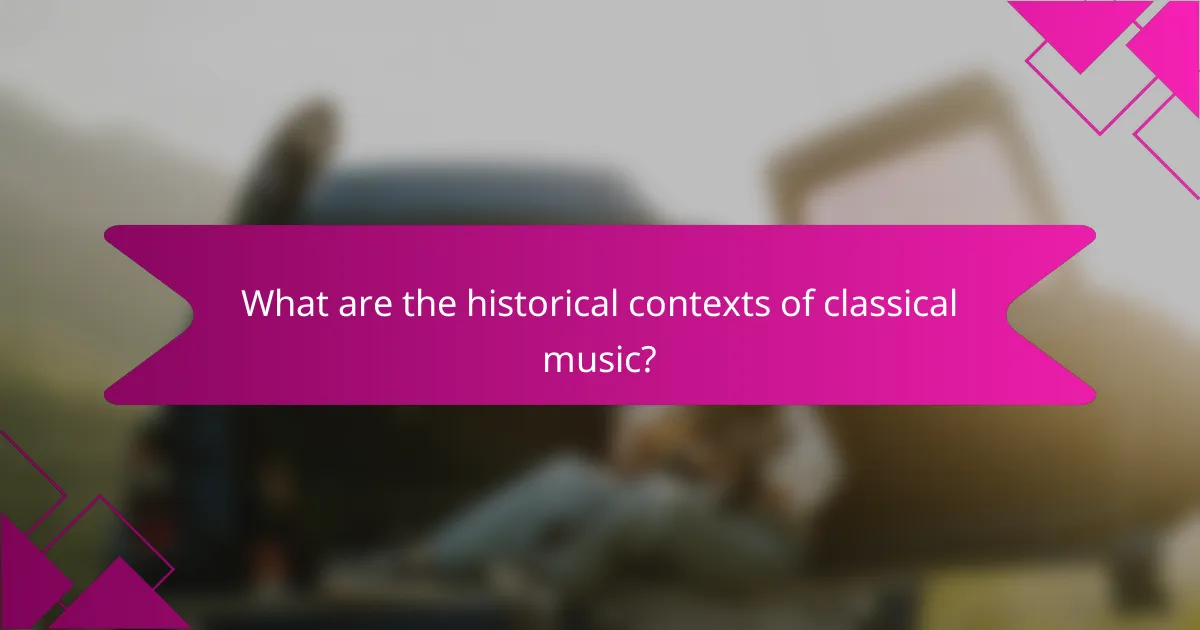
What are the historical contexts of classical music?
The historical contexts of classical music encompass the various cultural, social, and political influences that shaped its development over centuries. Understanding these contexts helps to appreciate the evolution of musical styles and the significance of compositions within their time periods.
Evolution through periods
Classical music evolved through distinct periods, each characterized by unique styles and innovations. The major periods include the Medieval (500-1400), Renaissance (1400-1600), Baroque (1600-1750), Classical (1750-1820), Romantic (1820-1900), and Modern (1900-present). Each era introduced new forms, instrumentation, and compositional techniques that reflected the changing tastes and societal values of the time.
For example, the Baroque period saw the rise of ornamentation and complex polyphony, while the Classical period emphasized clarity and balance, leading to the development of sonata form. The Romantic period, in contrast, focused on emotional expression and individualism, resulting in expansive symphonies and operas.
Influential composers and their contributions
Numerous composers have significantly influenced the trajectory of classical music, each contributing unique elements that shaped the art form. Figures such as Johann Sebastian Bach and Ludwig van Beethoven are pivotal, with Bach’s intricate counterpoint and Beethoven’s innovative structures pushing the boundaries of musical expression.
Other notable composers include Wolfgang Amadeus Mozart, whose mastery of melody and form set standards for future generations, and Claude Debussy, who introduced impressionistic techniques that altered harmonic language. These contributions not only defined their respective periods but also laid the groundwork for contemporary classical music.
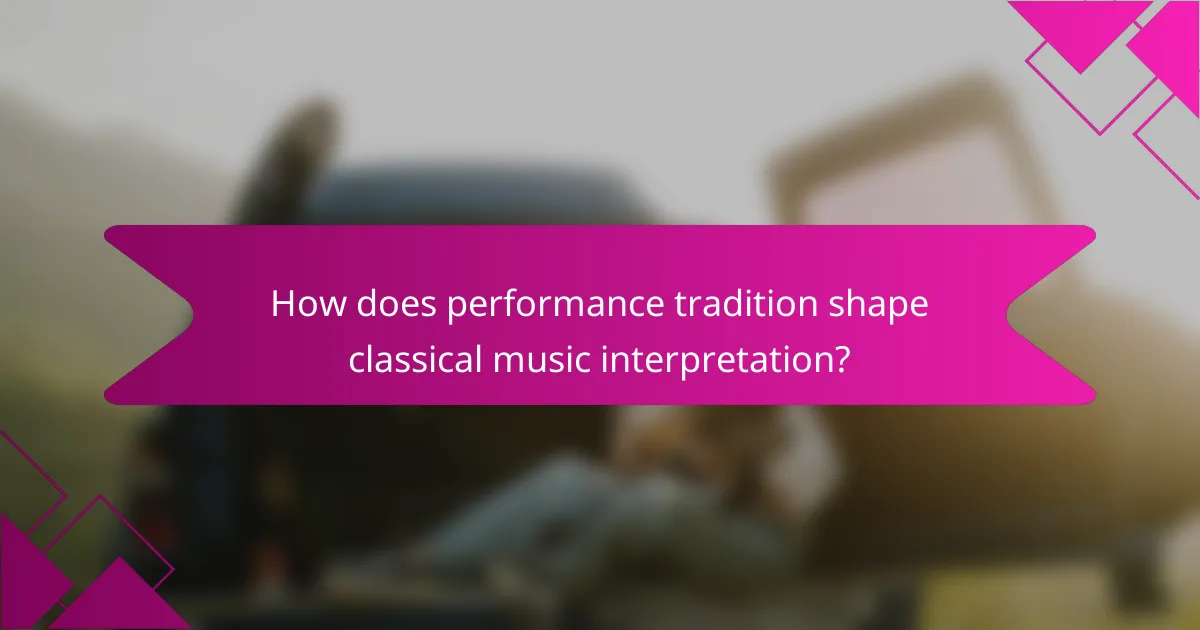
How does performance tradition shape classical music interpretation?
Performance tradition significantly influences how classical music is interpreted, affecting aspects like tempo, dynamics, and phrasing. Musicians often draw from historical practices and stylistic nuances that have evolved over time, leading to diverse interpretations of the same piece.
Differences in performance practices
Performance practices vary widely across different regions and periods, impacting how music is played. For instance, Baroque music often features ornamentation and a flexible tempo, while Romantic performances may emphasize expressiveness and emotional depth. These differences can lead to distinct listening experiences, even for the same composition.
Additionally, the use of instruments can differ. For example, modern orchestras typically use standardized instruments, while historically informed performances might utilize period instruments, which can alter the sound and character of the music.
Impact of historical performance movements
Historical performance movements, such as the Early Music movement, have reshaped classical music interpretation by advocating for authenticity and adherence to original practices. These movements often emphasize the importance of using period instruments and techniques, which can result in a more accurate representation of the composer’s intentions.
Furthermore, the rise of these movements has encouraged musicians to explore less conventional interpretations, leading to a richer diversity in performance styles. This evolution invites audiences to experience classical music in new and varied ways, enhancing appreciation for its historical context.
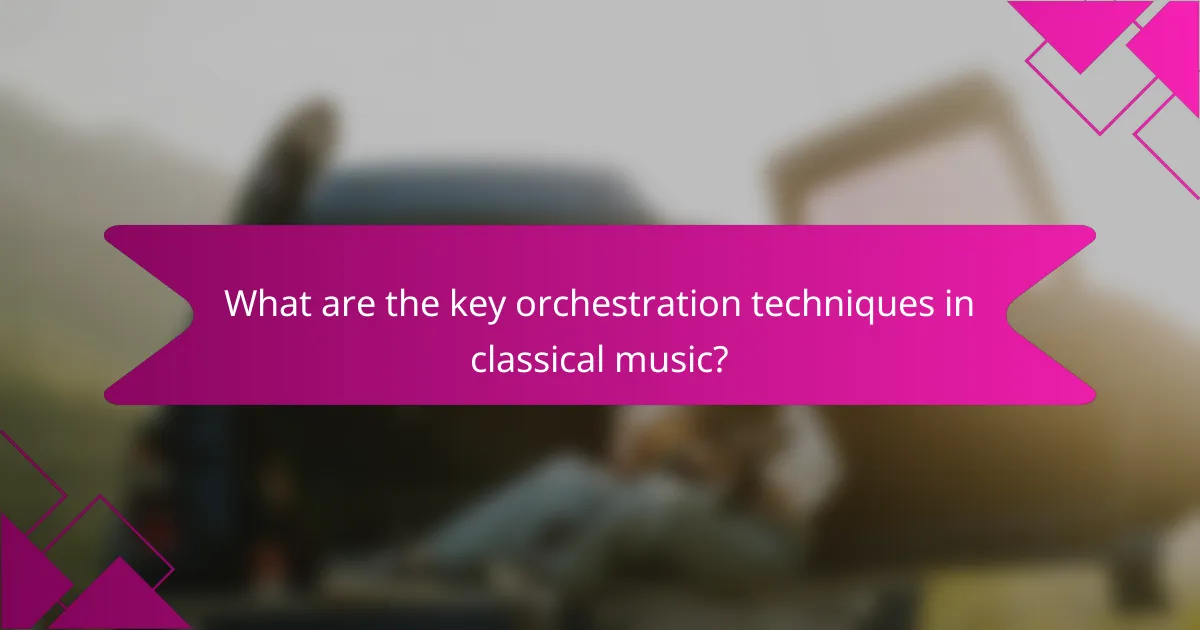
What are the key orchestration techniques in classical music?
Key orchestration techniques in classical music include layering and blending sounds, as well as the use of dynamics and articulation. These methods enhance the richness and expressiveness of musical compositions, allowing composers to create intricate textures and emotional depth.
Layering and blending sounds
Layering and blending sounds involve combining different instrumental timbres to create a fuller, more complex auditory experience. Composers often use this technique to highlight specific themes or motifs by juxtaposing contrasting instruments, such as strings with woodwinds or brass with percussion.
When layering, consider the balance between instruments to avoid overpowering any single part. For example, a common approach is to use strings as a foundation while adding woodwinds for color and brass for emphasis. This creates a harmonious blend that enhances the overall sound.
Use of dynamics and articulation
The use of dynamics and articulation is crucial for conveying emotion and drama in classical music. Dynamics refer to the volume of sound, while articulation involves the clarity and style of note production. Together, they help shape the character of a piece and guide the listener’s emotional response.
Effective dynamics can range from soft passages (piano) to powerful climaxes (forte), creating contrast and tension. Articulation techniques, such as staccato or legato, further define how notes are played, adding nuance to the performance. Composers should carefully mark these elements in their scores to ensure performers interpret them as intended.

How do cultural influences affect classical music?
Cultural influences significantly shape classical music by introducing unique regional characteristics, traditions, and collaborative efforts across genres. These elements contribute to the diversity and richness of classical compositions, reflecting the historical and social contexts from which they emerge.
Regional styles and variations
Regional styles in classical music often arise from the distinct cultural backgrounds of composers and musicians. For example, Eastern European classical music may incorporate folk melodies and rhythms, while Western European traditions might emphasize harmony and orchestration techniques. This results in a variety of sounds and performance practices that can vary widely even within the same country.
Notable examples include the use of modal scales in Balkan music and the influence of Russian folk themes in works by composers like Tchaikovsky. Understanding these regional variations can enhance both performance and appreciation of classical pieces, as musicians often adapt their interpretations to reflect these cultural nuances.
Cross-genre collaborations
Cross-genre collaborations have become increasingly common in classical music, allowing for innovative fusions that blend different musical styles. Collaborations between classical musicians and artists from genres like jazz, rock, or electronic music can create fresh interpretations and broaden the audience for classical works.
For instance, the collaboration between Yo-Yo Ma and various contemporary artists showcases how classical music can intersect with modern sounds, appealing to a wider demographic. These partnerships often lead to new compositions that incorporate elements from both genres, enriching the classical music landscape and encouraging creative exploration.

What are the emerging trends in classical music performance?
Emerging trends in classical music performance include the integration of technology and the rise of new compositions that embrace contemporary styles. These developments are reshaping how audiences experience classical music and how musicians engage with their craft.
Integration of technology
The integration of technology in classical music performance is transforming traditional practices. Musicians are increasingly using digital tools for sound enhancement, live streaming, and interactive experiences that engage audiences in novel ways.
For example, virtual reality concerts allow viewers to experience performances from unique perspectives, while software applications can assist in composing and arranging music. This trend not only broadens access to classical music but also encourages innovative interpretations of classic works.
New compositions and contemporary styles
New compositions and contemporary styles are gaining traction within classical music, reflecting current societal themes and diverse influences. Composers are blending genres, incorporating elements from jazz, pop, and world music to create fresh soundscapes that resonate with modern audiences.
Performers are also exploring these contemporary works, often collaborating with living composers to premiere new pieces. This shift not only revitalizes the classical repertoire but also fosters a dynamic performance tradition that appeals to a wider demographic.
